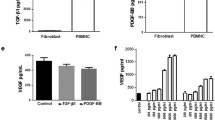The effectiveness of autologous cell product in the therapy of skin burn wounds was studied in C57B1/6 male mice against the background of streptozotocin-induced diabetes mellitus. In animals with and without modeled diabetes mellitus, significant decrease in skin defect area was observed after single administration of the cell product (bone marrow multipotent mesenchymal stromal cells, fibroblasts or media conditioned by these cells).
Similar content being viewed by others
References
Konenkov VI, Klimontov VV. Gene and cell-based technologies for the treatment of diabetic foot syndrome. Sakharn. Diabet. 2014;(1):63-69. Russian.
Konenkov VI, Klimontov VV, Kuznetsova IV. Impaired angiogenesis and lymphangiogenesis in diabetes mellitus. Arkh. Patol. 2014;76(2):55-59. Russian.
Lykov AP, Bondarenko NA, Sakhno LV, Shevela EY, Poveschenko OV, Kim II, Nikonorova YV, Konenkov VI. The impact of secretory factors endothelial cells on the functional activity of human multipotent mesenchymal stromal cells. Fundametal. Issled. 2014;(4-2):296-301. Russian.
Bernardi S, Severini GM, Zauli G, Secchiero P. Cell-based therapies for diabetic complications. Exp. Diabetes Res. 2012; 2012. ID 872504. doi: https://doi.org/10.1155/2012/872504.
Chen L, Tredget EE, Wu PY, Wu Y. Paracrine factors of mesenchymal stem cells recruit macrophages and endothelial lineage cells and enhance wound healing. PLoS One. 2008;3(4):e1886. doi: https://doi.org/10.1371/journal.pone.0001886.
Heo SC, Jeon ES, Lee IH, Kim HS, Kim MB, Kim JH. Tumor necrosis factor-α-activated human adipose tissue-derived mesenchymal stem cells accelerate cutaneous wound healing through paracrine mechanisms. J. Invest. Dermatol. 2011;131(7):1559-1567.
Ichim TE, Solano F, Lara F, Paris E, Ugalde F, Rodriguez JP, Minev B, Bogin V, Ramos F, Woods J, Murphy MP, Patel AN, Harman RJ, Riordan NH. Feasibility of combination allogeneic stem cell therapy for spinal cord injury: a case report. Int. Arch. Med. 2010;3:30. doi: https://doi.org/10.1186/1755-7682-3-30.
Pasha Z, Wang Y, Sheikh R, Zhang D, Zhao T, Ashraf M. Preconditioning enhances cell survival and differentiation of stem cells during transplantation in infarcted myocardium. Cardiovasc. Res. 2008;77(1):134-142.
Perin EC, Tian M, Marini FC 3rd, Silva GV, Zheng Y, Baimbridge F, Quan X, Fernandes M.R, Gahremanpour A, Young D, Paolillo V, Mukhopadhyay U, Borne A.T, Uthamanthil R, Brammer D, Jackson J, Decker WK, Najjar AM, Thomas MW, Volgin A, Rabinovich B, Soghomonyan S, Jeong HJ, Rios JM, Steiner D, Robinson S, Mawlawi O, Pan T, Stafford J, Kundra V, Li C, Alauddin MM, Willerson JT, Shpall E, Gelovani JG. Imaging long-term fate of intramyocardially implanted mesenchymal stem cells in a porcine myocardial infarction model. PLoS One. 2011;6(9):e22949. doi: https://doi.org/10.1371/journal.pone.0022949.
Sasaki M, Abe R, Fujita Y, Ando S, Inokuma D, Shimizu H. Mesenchymal stem cells are recruited into wounded skin and contribute to wound repair by transdifferentiation into multiple skin cell type. J. Immunol. 2008;180(4):2581-2587.
Wan J, Xia L, Liang W, Liu Y, Cai Q. Transplantation of bone marrow-derived mesenchymal stem cells promotes delayed wound healing in diabetic rats. J. Diabetes Res. 2013;2013. ID 647107. doi: https://doi.org/10.1155/2013/647107.
Author information
Authors and Affiliations
Corresponding author
Additional information
Translated from Kletochnye Tekhnologii v Biologii i Meditsine, No. 3, pp. 175-177, July, 2017
Rights and permissions
About this article
Cite this article
Lykov, A.P., Bondarenko, N.A., Poveshchenko, O.V. et al. Prospect of Using Cell Product for the Therapy of Skin Defects in Diabetes Mellitus. Bull Exp Biol Med 164, 266–268 (2017). https://doi.org/10.1007/s10517-017-3970-0
Received:
Published:
Issue Date:
DOI: https://doi.org/10.1007/s10517-017-3970-0




